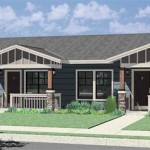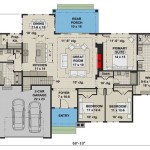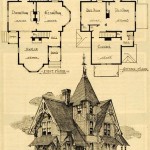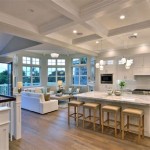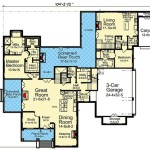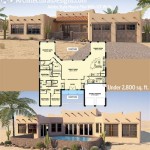Home Plans Designed for Outdoor Living
The desire to connect with nature and extend living spaces beyond the confines of interior walls has led to a growing demand for home plans specifically designed to embrace outdoor living. These plans prioritize seamless transitions between indoor and outdoor areas, incorporating features that encourage relaxation, entertainment, and a deeper appreciation for the surrounding environment. Understanding the key elements of these plans can help prospective homeowners make informed decisions and create outdoor spaces that truly enhance their lifestyle.
Integration of Indoor and Outdoor Spaces
A fundamental aspect of home plans for outdoor living is the blurring of lines between the indoors and outdoors. This is achieved through various architectural and design strategies, resulting in a cohesive and functional living environment. Large windows, sliding glass doors, and bi-fold door systems play a crucial role in creating expansive openings that allow natural light to flood the interior while providing easy access to outdoor areas. These openings promote a sense of openness and connection with the natural landscape.
The strategic placement of living areas, such as kitchens, dining rooms, and living rooms, adjacent to outdoor spaces is another vital element. This arrangement allows for convenient flow between these areas, making it easier to prepare meals indoors and serve them outdoors or to seamlessly transition from indoor relaxation to outdoor entertainment. Consider, for example, a kitchen with a large island and a pass-through window to an outdoor bar area. This design facilitates effortless communication and service between the indoor chef and outdoor guests.
Covered patios, porches, and decks are also essential components in integrating indoor and outdoor spaces. These features provide sheltered areas that can be enjoyed regardless of weather conditions. A covered patio, for example, can serve as an outdoor dining room, a relaxation zone, or an entertainment area, extending the usability of the outdoor space throughout the year. Furthermore, screened porches can offer protection from insects, allowing for comfortable outdoor enjoyment even during mosquito season.
The use of similar materials and design styles in both indoor and outdoor areas creates a sense of visual continuity and reinforces the connection between the two spaces. For instance, using the same flooring material in the kitchen and on the adjacent patio or deck can create a seamless transition. Similarly, incorporating the same architectural details, such as trim work and lighting fixtures, can further enhance the cohesive aesthetic.
Key Features and Amenities for Outdoor Living
Beyond the basic integration of indoor and outdoor spaces, home plans for outdoor living often incorporate specific features and amenities designed to enhance the outdoor experience. These features can range from simple elements like outdoor seating areas to more elaborate installations like outdoor kitchens and swimming pools. The choice of features will depend on the homeowner's lifestyle, preferences, and budget.
Outdoor kitchens are a popular addition to many outdoor living spaces. These kitchens can range from a simple grill and countertop to a fully equipped cooking area with a sink, refrigerator, and ample storage. An outdoor kitchen allows homeowners to prepare and cook meals outdoors, eliminating the need to constantly go back and forth between the indoor kitchen and the outdoor entertaining area. This fosters a more social and relaxed atmosphere for outdoor gatherings.
Fire pits and fireplaces are another common feature in outdoor living plans. These elements provide warmth and ambiance, extending the usability of the outdoor space into the cooler months. A fire pit can serve as a focal point for conversation and relaxation, while an outdoor fireplace can create a cozy and inviting atmosphere for outdoor dining or lounging. Consider the placement of the fire feature in relation to seating areas and wind direction to maximize comfort and enjoyment.
Swimming pools and spas are often incorporated into home plans for outdoor living, providing a refreshing and enjoyable way to cool off during hot weather. The design and placement of the pool can significantly impact the overall outdoor living experience. Consider the size and shape of the pool, as well as its proximity to other outdoor features, such as patios, decks, and outdoor kitchens. A well-designed pool area can become the centerpiece of the outdoor living space.
Outdoor seating and dining areas are essential components of any outdoor living space. These areas should be designed to accommodate the homeowner's lifestyle and entertaining needs. Consider the size of the seating area, the type of furniture, and the arrangement of the furniture to create a comfortable and inviting space for relaxation and socializing. A dining area should be large enough to accommodate the desired number of guests and should be located in a convenient location near the outdoor kitchen or grill.
Landscaping plays a crucial role in creating a visually appealing and functional outdoor living space. The selection of plants, trees, and shrubs should be carefully considered to create a harmonious and aesthetically pleasing environment. Consider the climate, soil conditions, and desired aesthetic when choosing plants. Landscaping can also be used to provide privacy, shade, and wind protection.
Considerations for Planning and Design
Developing a home plan for outdoor living requires careful planning and consideration of various factors. These factors include the site's orientation, climate, local building codes, and the homeowner's budget and lifestyle. A well-thought-out plan will ensure that the outdoor space is both functional and aesthetically pleasing.
The orientation of the house on the building site is a crucial consideration. The orientation will affect the amount of sunlight that the outdoor spaces receive, which can impact the comfort and usability of these areas. For example, a south-facing patio will receive the most sunlight, while a north-facing patio will be more shaded. Consider the orientation when planning the placement of outdoor features, such as seating areas, dining areas, and swimming pools.
The local climate is another important factor to consider. The climate will influence the choice of materials, plant selections, and the design of covered areas. In hot climates, it is important to provide ample shade and ventilation to keep outdoor spaces cool and comfortable. In cold climates, it is important to provide warmth and wind protection to extend the usability of the outdoor space into the cooler months.
Local building codes and regulations must also be taken into account when planning an outdoor living space. These codes may regulate the size and placement of structures, the use of certain materials, and the installation of utilities. It is important to consult with local building officials to ensure that the plan complies with all applicable regulations.
The homeowner's budget is a significant constraint in any construction project. It is important to establish a realistic budget and to prioritize the features that are most important. Outdoor living spaces can range from simple and affordable to elaborate and expensive. Carefully consider the costs associated with each feature and make choices that align with the budget.
Finally, the homeowner's lifestyle should be a primary consideration when planning an outdoor living space. The outdoor space should be designed to accommodate the homeowner's specific needs and preferences. Consider how the space will be used, who will be using it, and what activities will take place there. A well-designed outdoor living space will enhance the homeowner's quality of life and provide years of enjoyment.
Designing for outdoor living requires a holistic approach that integrates landscape, architecture, and lifestyle. By focusing on creating seamless transitions between indoor and outdoor spaces, incorporating essential features and amenities, and considering factors like orientation, climate, building codes, budget, and lifestyle, homeowners can create outdoor spaces that are both functional and beautiful.

Our Best Outdoor Living Space Ideas For Your Home House Plan News

Plan 56408sm 4 Bed Acadian With Generous Outdoor Living Space

Unique Courtyard House Plans With Outdoor Living Dining

Patio Home Floor Plans House For Outdoor Living The Designers

Patio Home Floor Plans House For Outdoor Living The Designers

House Plans Inspiring Outdoor Living Spaces Dfd Blog

How To Design Your Outdoor Living Space

House Plans With Great Outdoor Living Spaces Dfd Blog

Plan For Indoor Outdoor House

House Plans With Roof Deck Terraces Blog Eplans Com

